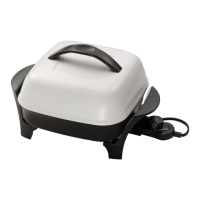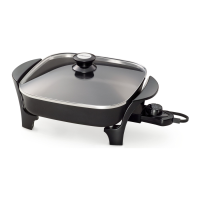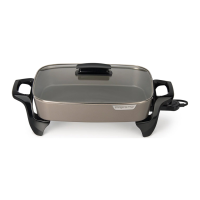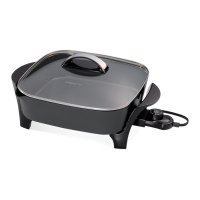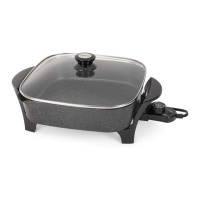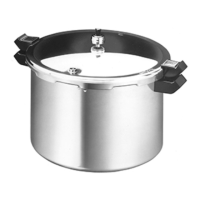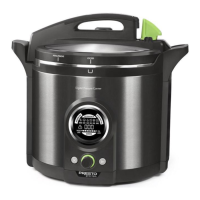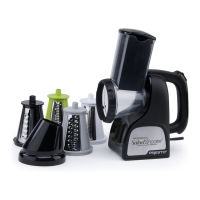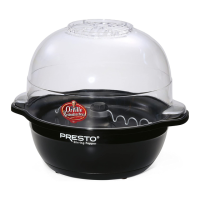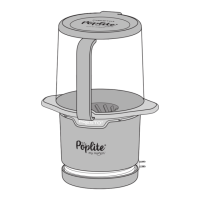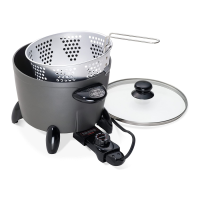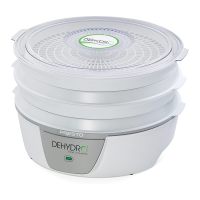8
Uses
Dried vegetables have a unique flavor and texture and are best used as ingredients for soups, stews, casseroles, and sauces rather than
stand-alone side dishes. When using in soups, dried vegetables can be added without soaking. Dried vegetables used for other purposes
need to be soaked before cooking. To soak, start with 1½ to 2 cups of boiling water for every 1 cup of dried vegetables. Soak for 1 to 2
hours or until vegetables have returned to nearly the same size they were before dehydrating. Additional water should be added as needed
during the soaking process. After soaking, simmer the vegetables in the soaking water until tender, allowing excess water to evaporate.
Drying Herbs
Drying fresh herbs allows you to have a ready supply of economical herbs that are available to use all through the year. To retain the best
flavor of your herbs, it is recommended that you dry them at the lowest temperature setting, 95°F (35°C).
Selection and Preparation
Pick herbs for drying just before the flowers first open. These herbs will be the most flavorful. The best time to pick herbs is in the early
morning just after the dew has evaporated. Rinse leaves and stems in cool water to remove any dust or insects and then gently shake to
remove excess water. Remove dead and bruised leaves or stems. Large leafed herbs, such as basil, sage, and mint, should be removed
from their stems for faster drying. Smaller leafed herbs can be left on their stem and removed after drying. Placing the herbs on a mesh
screen will help prevent them from falling through the grates in the tray during dehydration.
Determining Dryness
Herbs are acceptably dry when they are crispy and crumble easily. Refer to the Herb Drying Guide below and begin checking the herbs
at the beginning of the average drying time range. Remove a few herbs from each dehydrator tray and allow to cool to room temperature.
If the herbs do not crumble easily, recheck every hour.
Packaging and Storage
Dried leaves are best stored whole and then crumbled when needed. Follow “Packaging and Storing Dried Food” information on page 10.
Uses
Most dried herbs are 3 to 4 times stronger than the fresh herbs, therefore when using dried herbs in a recipe that calls for fresh herbs, use
¼ to ⅓ of the amount called for in the recipe.
HERB DRYING GUIDE
Dry herbs at 95°F (35°C).
Herb Average Drying Time Herb Average Drying Time Herb Average Drying Time
Basil leaves* 12–20 hours Fennel 3–5 hours Rosemary leaves 8–12 hours
Bay leaves 5–7 hours Marjoram leaves 9–12 hours Sage leaves 12–16 hours
Chives 9–15 hours Mint leaves 9–14 hours Tarragon leaves 5–7 hours
Cilantro leaves 6–8 hours Oregano leaves 9–12 hours Thyme leaves 4–6 hours
Dill leaves 3–5 hours Parsley leaves 6–8 hours
* Break veins to speed drying.
Drying Meat/Poultry
Homemade jerky is a flavorful dried meat product that is especially popular with outdoor sports enthusiasts because it is light and easy
to transport. Jerky can be made from most lean meat, including beef, pork, or venison,
**
or poultry
Whenever handling meat, basic food safety precautions need to be observed:
• Wash hands thoroughly before and after handling raw food.
• Keep product refrigerated or frozen until ready to use.
• Raw meat/poultry and its juice should be kept away from other foods. Wash cutting boards, utensils, counters, etc. with hot, soapy
water after contact with raw meat. After washing, sanitize with a solution of 1 tablespoon chlorine bleach per gallon of water. Allow
surface to air dry.
• Marinate meat/poultry under refrigeration. Discard marinade after meat/poultry is removed.
• Keep raw meat/poultry and dried jerky separate.
CAUTION! The United States Department of Agriculture (USDA) recommends that meat/poultry be precooked prior to dehydrating or
baked after dehydrating to reduce the risk of foodborne illness.
**Venison or wild game meat that has been contaminated with entrails should not be used for making jerky.
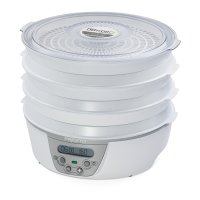
